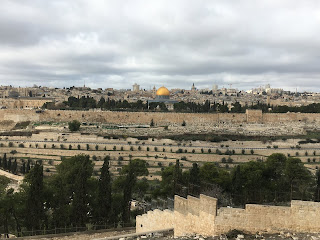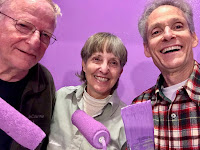We decided we didn't need any flowers, but wouldn't it be wonderful to bring some flowers back to Asha. We scanned through the numerous varieties, and only one had blue blossoms. Not exactly nayaswami blue, but a nice, violet blue. So we bought one bunch.
They were light to carry, as they swung along in their plastic sheath, safe from bumps and bruises. During the long walk home, we discussed how to deliver them. Should we bring them downstairs to dinner? We could add a bit of water to their bag and hang them on her doorknob. We didn't know her room number. We could get it from the front desk. They might not be allowed to give out guest room numbers. We could call her. She might be in seclusion, recharging between pilgrimages.
So we brought them down to dinner, as the least invasive strategy.
The cafeteria was closed.
There were too few guests in the hotel to warrant opening up the cafeteria buffet, so we ate in the small cafe off the main lobby. Delicious soup. Yummy salad. No Asha.
So the flowers stayed in our hotel room that night.
And the next.
And the next.
When we brought the flowers home, they were tight little buds, perfect for longevity in an elegantly simple vase. Maybe by keeping them longer than expected, it would give them time to blossom into vibrant color. By the time they started to open, their leaves were starting to shrivel slightly along the edges. Plus, they drank a LOT of water, so much so, they spent one afternoon water-free, drooping pathetically around their short, stubby coffee cup, the only vase we had available, completely devoid of elegance.
So they stayed in our room, recovering. Which they did!
They were some kind of poppy-ish flower, with papery petals, long stems, and a burst of leaves just below each blossom, splayed hands announcing "Ta-da". They were a cross between Dr. Seuss and Charlie Brown's Christmas tree. I loved them.
Soon it was too close to the time of our departure for Tiberius, which would create a dilemma for Asha. Should she throw them away or try to carry them through a day of bus travel? I decided I would carry them for Asha. So they stayed in our room, waiting.
I put them back into their plastic sheath, added a half cup of water, and hung them from the back of the bus seat in front of me, Asha's seat, as it happened, and there they swayed along, peering out at the passing country side or dozing in the sun dribbling through the window as the bus waited in successive parking lots while the pilgrims wandered holy sites, listening to Asha whisper in their ears about the spiritual significance of each spectacular church or field or sea.
Finally we and the flowers, shriveled from their sunbathing, arrived at our hotel in Tiberius. As we were waiting for our luggage to trickle out from the depths of the bus's undercarriage, Asha strolled over to smile at us and peer down onto the forlorn flowers peaking, one-eyed, out of their plastic sheath.
"Oh. Huh," she said, politely.
Dambara and I grinned at each other. "These are actually your flowers. We bought them for you last week."
She burst out laughing, appropriately.
"They used to be in better shape, but they were always a bit bedraggled," I explained.
She couldn't stop laughing. "Here are some scrawny flowers for you," she mimicked. "We bought them especially for you."
I should note that Dambara and I were laughing just as much as Asha.
"We were going to leave them on your doorknob, but we didn't know your room number."
"I was in hiding," she admitted.
"We figured as much," I admitted.
"Well, this certainly is a case of it's the thought that counts." She was still laughing,
"Absolutely!" We agreed.
Threading our way through the throng in the hotel lobby, clutched card keys in hand, I ended up sharing the tiny elevator with two, polite Indian men from the pilgrimage. They politely stared at my bag of bedraggled flowers. "They've had a long day of traveling," I smiled. "The bus was a bit hard on them." They nodded politely and smiled politely. "They're Asha's flowers, but I ended up keeping them." They nodded politely. Empathizing. Wise decision, I could hear them politely musing.
I brought the flowers into our hotel room, found them another, non-elegant coffee cup, cut off six inches of their stems, and tucked them into fresh water. They perked right up.
I think they're lovely.
 |
| Asha's flowers |










































